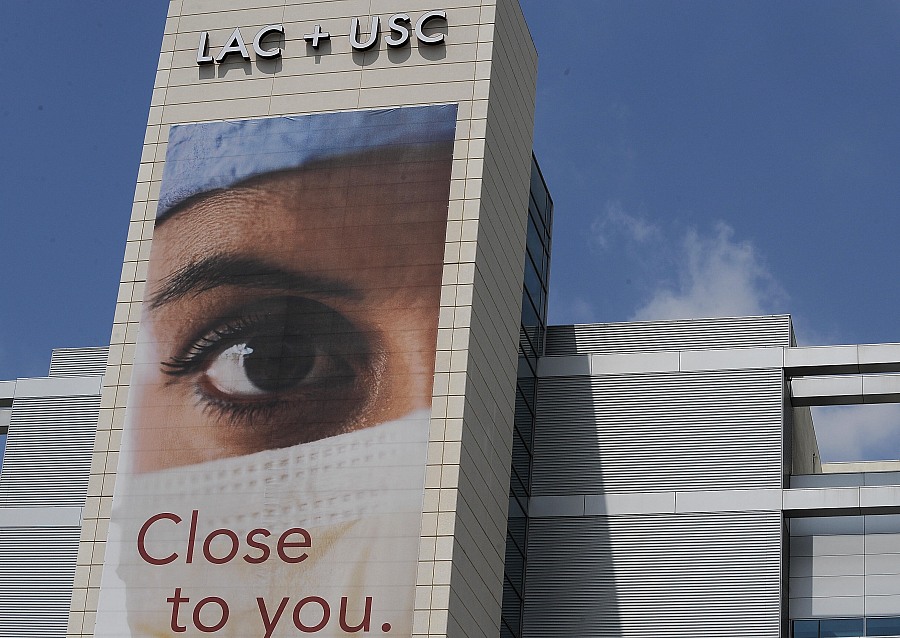With patients in need of more than medicine, LA’s biggest safety net hospital overhauls primary care

Milestones shape the constellations of our life.
Los Angeles County-USC Medical Center is the Orion shaping Juan’s life. Born at the county hospital, the baby of four sisters and one brother was scarred by alcohol before ever taking a drink.
“Alcohol was always around,” Juan said, sharing his story with fellows at the 2018 California Fellowship this week.
Juan’s earliest memories are his parents constantly arguing and fighting — until they ultimately broke apart. His mother was faced with the choice between her youngest child or her new boyfriend.
She chose the latter.
“My depression started as a teen,” he said.
Juan joined a gang in high school. They accepted and cared for him when his parents failed to show that was possible.
“I joined a gang for family,” he said. “My heart has always been broken,” he later added.
When he was 16, he paid the price in blood. Juan can describe the feeling of being pierced with a bullet. But it would take the slice of a machete to bring him back to his birthplace. The county hospital saved his life.
Juan dabbled in drugs, but quit after seeing the destructive toll it had on his friends. Alcohol, however, was fun. It went with parties, BBQ and music.
“Alcohol would take away my problems,” he said.
Alcohol also ripped away Juan’s stability and health, to the point where he was living in a tent. He was depressed, scared, hearing voices and suicidal.
So Juan returned repeatedly to a place that was familiar, a “frequent flier” at the county hospital for three years. Taylor, a substance abuse counselor, repeatedly tried to help Juan, without success.
“I saw Juan’s name a couple hundred times,” he said.
Eighteen months in, Juan made a pivot in his downward spiral. LAC+USC Medical Center was amid big changes in how it approached patient care.
The idea seems simple: “Treat the person, not the disease.”
The county hospital now brings together more than a dozen disciplines. This team of providers is present from a patient’s first visit, ready to offer treatment and connect patients with services and resources then and there.
Patients are now asked a series of questions my medical assistants, nurses and doctors that try to get at some of the underlying social factors shaping their health.
“We are the touch points to resources… we have to ask these questions. Every visit. Every time,” said Jagruti Shukla, primary care director at LAC+USC.
Screening questions are designed to get to the root of their pain — often bringing in social workers, mental health therapists, substance abuse counselors, even locating housing resources as well as food assistance.
“We never ask a question we can’t deal with in normal time.”
Shukla said that an individual’s behaviors and social environment impacts their health and wellbeing by 60 percent, while genetics and the health care system make up the remaining.
The idea is that someone is more likely to take part in long-term preventative care, such as diabetes or high blood pressure, when they feel secure and stable.
“We are members of an orchestra where we each have skills in what we do,” Shukla said.
As a medical assistant, Malitza Lobos contributes the first notes in addressing a patient’s social needs.
While taking vital signs, she asks patients screening questions that go beyond immediate symptoms — the goal is to learn if other factors such as their job, housing, mental health, family, or food insecurities are also in need of “treatment.”
That means physicians and medical staff need to build a relationship and gain trust with their patients.
Primary care physician Dr. Joanne Suh could have simply treated the abscess on the arm of one of her patients, which was at risk of requiring amputation after chronic heroin use.
But Suh also connected Alicia with a team of community health, nurse and substance abuse staff — even delving into Alicia’s relationship with her mother and father to better understand their dynamics.
“We get deep sometimes with our patients,” Suh said. “She felt for the first time she wasn’t treated as a drug addict, but as Alicia.”
LAC+USC Medical Center sees close to 60,000 patients each year, according to Shukla. It’s new team-based primary care model was largely achieved by shifting resources and drawing on new partnerships — such as bringing in trainees through the university’s department of psychiatry and behavioral sciences, as well as reaching out to community nonprofits to expand treatments and resources.
Dr. Barbara Rubino, medical director for the adult clinics at LAC+USC, says the team-based, behavioral treatment model has led to a 43 percent increase in connecting patients with depression and anxiety resources. And almost a quarter of patients have been identified with food insecurity and connected to resources. The shift to team-based care has also led to a significant decrease in blood pressure for many patients.
It’s part of a cultural shift in medicine, where a team of providers is now collectively accountable for the care of a patient.
“This sounds obvious, but it’s not. This is not how we train,” Shukla said.
It brings to bear a constellation of treatment and resources that curve, bend, and wrap around each patient.
In Juan’s case, his journey through LAC+USC Medical Center has now led to one year of sobriety and a stable home.
“I have a bed,” he said. “Every time I lay down, I thank God.”
[Photo: Robyn Beck/AFP/Getty Images]

